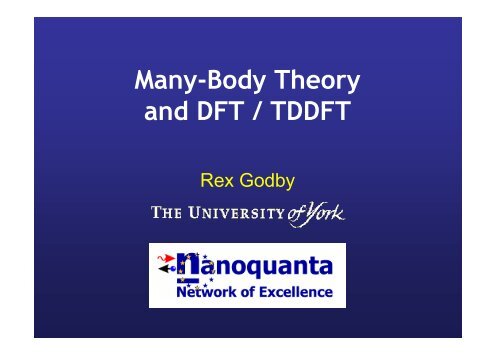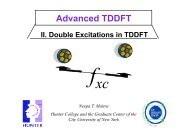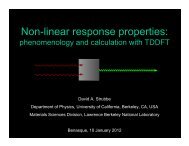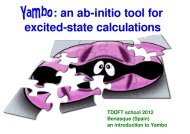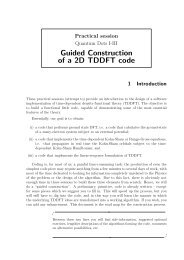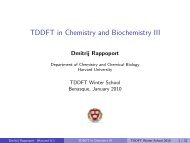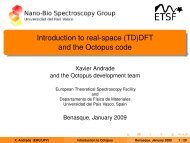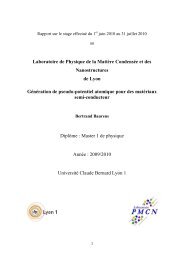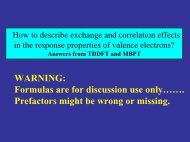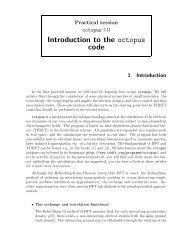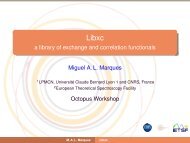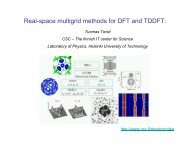Many-Body I - TDDFT.org
Many-Body I - TDDFT.org
Many-Body I - TDDFT.org
You also want an ePaper? Increase the reach of your titles
YUMPU automatically turns print PDFs into web optimized ePapers that Google loves.
<strong>Many</strong>-<strong>Body</strong> Theory<br />
and DFT / <strong>TDDFT</strong><br />
Rex Godby
Outline<br />
• Introduction to many-body perturbation<br />
theory<br />
• The GW approximation (non-SC and SC)<br />
• Implementation of GW<br />
• Spectral properties<br />
• GW total energy<br />
• Vertex corrections beyond GW<br />
<strong>Many</strong>-body theory and <strong>TDDFT</strong> - Benasque, 30/31 Aug 2006 2<br />
+
The Basic Problem<br />
Nucleus α (fixed)<br />
Electron i<br />
( H ˆ − E)Ψ ( r 1 , r 2 ,...r N ) = 0, where<br />
∑<br />
H ˆ = − 1 2 ∇ i 2<br />
i<br />
+ 1 2<br />
i≠ j<br />
−<br />
+ 1 2<br />
∑<br />
∑<br />
1<br />
r i − r j<br />
Z α<br />
electronic K. E<br />
e - e interaction<br />
r i − R α<br />
electronic P.E.<br />
Z α Z β<br />
∑<br />
α ≠β R α − R β<br />
nucleus - nucleus P. E.<br />
iα<br />
• The second term makes the problem interesting!<br />
(Otherwise see undergraduate courses: Bloch’s<br />
theorem, energy bands, etc.)<br />
<strong>Many</strong>-body theory and <strong>TDDFT</strong> - Benasque, 30/31 Aug 2006 3
Approaches to the<br />
electron-electron interaction<br />
• Density-functional theory (for ground-state properties only):<br />
[ − 1 2 ∇2 + V ext (r) + V Hartree (r) + V xc (r) − ε i ]ψ i (r) = 0<br />
• <strong>Many</strong>-body perturbation theory based on Green’s functions:<br />
[ − 1 2 ∇2 + V ext + V Hartree + Σ xc (ω ) − ω]G(r, r ′,ω) = δ(r − r ′)<br />
(which, inter alia, leads to the quasiparticle equation<br />
[ − 1 2 ∇2 + V ext + V Hartree + Σ xc (ε) − ε]ψ (r) = 0)<br />
Note the two ways of describing exchange and correlation:<br />
In DFT: V xc (r) (local, energy-independent potential)<br />
In many-body theory: Σ xc (r, r ′,ω ) (non-local, energydependent<br />
potential)<br />
<strong>Many</strong>-body theory and <strong>TDDFT</strong> - Benasque, 30/31 Aug 2006 4
Some Pathologies of the KSDFT<br />
functional<br />
δE<br />
[ n]<br />
• Band-gap problem: V ( r)<br />
xc<br />
xc =<br />
δn(<br />
r)<br />
is discontinuous (by a constant) when an electron is added to an<br />
insulator (Sham and Schlüter, Perdew and Levy 1983)<br />
• Widely separated open-shell atoms: V xc(r)<br />
has a peculiar spatial<br />
variation between distant atoms so as to equalise highest occupied<br />
states (Almbladh and von Barth 1985)<br />
• Exchange-correlation “electric field” accompanies real electric field in<br />
an insulator (Godby and Sham 1994, Gonze, Ghosez and Godby 1995)<br />
<strong>Many</strong>-body theory and <strong>TDDFT</strong> - Benasque, 30/31 Aug 2006 5
Introduction to <strong>Many</strong>-<strong>Body</strong><br />
Perturbation Theory
Key ideas of many-body<br />
perturbation theory<br />
• Electronic and optical experiments often measure some<br />
aspect of the one-particle Green’s function<br />
• The spectral function, Im G, tells you about the singleparticle-like<br />
approximate eigenstates of the system: the<br />
quasiparticles Im G non-interacting<br />
interacting<br />
E 1 E 2 µ<br />
• G obtained from self-energy Σ(r,r´,E)<br />
• Σ = GW + O(W 2 ); W = screened Coulomb interaction<br />
ω<br />
<strong>Many</strong>-body theory and <strong>TDDFT</strong> - Benasque, 30/31 Aug 2006 7<br />
+
Second Quantisation<br />
• Field operators add/remove an electron at<br />
r with spin σ (x=r,σ) at time t<br />
ψ<br />
ˆ †( x,<br />
t)<br />
ˆ ( x,<br />
t)<br />
• Defined rigorously in terms of operation on<br />
Slater determinants<br />
• Have equations of motion in the<br />
Heisenberg representation that follows<br />
from the TDSE<br />
;<br />
ψ<br />
<strong>Many</strong>-body theory and <strong>TDDFT</strong> - Benasque, 30/31 Aug 2006 8
1-particle Green's Function G<br />
• One-particle Green's function<br />
G ( x,<br />
x';<br />
t − t')<br />
≡ −i<br />
N T[<br />
ψ ˆ ( x,<br />
t)<br />
ψˆ<br />
( x',<br />
t'<br />
)] N<br />
+<br />
where x ≡ ( r,<br />
ξ)<br />
is space+spin, N = N-electron ground state,<br />
T=time-ordering operator<br />
<strong>Many</strong>-body theory and <strong>TDDFT</strong> - Benasque, 30/31 Aug 2006 9
G as a Propagator<br />
G ( x,<br />
x';<br />
t − t')<br />
≡ −i<br />
N T[<br />
ψ ˆ( x,<br />
t)<br />
ψˆ<br />
( x',<br />
t'<br />
)]<br />
+<br />
N<br />
ψˆ †( r'<br />
t')<br />
ψˆ<br />
( rt)<br />
<strong>Many</strong>-body theory and <strong>TDDFT</strong> - Benasque, 30/31 Aug 2006 10
Lehmann Representation for G<br />
G(<br />
rt;<br />
r'<br />
t')<br />
=<br />
f<br />
s<br />
⎪⎧<br />
( r)<br />
= ⎨<br />
⎪⎩<br />
∑<br />
s<br />
Nψˆ ( r)<br />
fs<br />
( r)<br />
fs<br />
ω −ε<br />
N + 1, s<br />
N −1,<br />
sψˆ ( r)<br />
N<br />
s<br />
*( r')<br />
∓ iδ<br />
, ε<br />
, ε<br />
s<br />
s<br />
⎧<<br />
⎫<br />
, ε<br />
s ⎨ ⎬µ<br />
⎩><br />
⎭<br />
=<br />
=<br />
E<br />
E<br />
N + 1, s<br />
N<br />
−<br />
−<br />
E<br />
E<br />
N<br />
N −1,<br />
s<br />
> µ<br />
< µ<br />
• s labels the excited states of the N+1 or N-1-<br />
electron systems<br />
• G has its poles at each energy with which an<br />
electron can be added/removed<br />
<strong>Many</strong>-body theory and <strong>TDDFT</strong> - Benasque, 30/31 Aug 2006 11
Spectral function and<br />
quasiparticles from Im G<br />
Im G non-interacting<br />
interacting<br />
E E µ<br />
1 2<br />
ω<br />
[ − 1 2 ∇2 + V ext + V Hartree + Σ xc (ε) − ε]ψ (r) = 0)<br />
<strong>Many</strong>-body theory and <strong>TDDFT</strong> - Benasque, 30/31 Aug 2006 12
Equation of Motion of G<br />
• Using equation of motion of field<br />
operators, G can be shown to satisfy<br />
⎛<br />
⎜i<br />
⎝<br />
∂<br />
∂t<br />
−<br />
⎞<br />
h(<br />
x)<br />
⎟G(<br />
xt;<br />
⎠<br />
x'<br />
t')<br />
+<br />
i<br />
∫<br />
v(<br />
r,<br />
r')<br />
N T[<br />
ψˆ<br />
ψψψ ˆ ˆ ˆ<br />
†<br />
†<br />
]<br />
N<br />
d<br />
4<br />
x<br />
−<br />
∫ ΣG<br />
= δ ( x<br />
−<br />
x')<br />
δ ( t<br />
−t')<br />
- defines Σ<br />
<strong>Many</strong>-body theory and <strong>TDDFT</strong> - Benasque, 30/31 Aug 2006 13
⎛<br />
⎜i<br />
⎝<br />
⎛<br />
⎜i<br />
⎝<br />
Green's Functions and Self-<br />
Energies<br />
• G obeys a very similar equation to the<br />
Green’s function of the Kohn-Sham<br />
electrons in DFT, but with the non-local,<br />
time-dependent Σ replacing V xc :<br />
∂<br />
∂t<br />
∂<br />
∂t<br />
−<br />
−<br />
{ h + V + Σ}<br />
H<br />
⎞<br />
⎟G(<br />
xt;<br />
x'<br />
t')<br />
⎠<br />
= δ ( x<br />
−t')<br />
{ h + V + V } G ( xt;<br />
x'<br />
t')<br />
= δ ( x − x')<br />
δ ( t −t'<br />
)<br />
H<br />
xc<br />
⎞<br />
⎟<br />
⎠<br />
KS<br />
− x')<br />
δ ( t<br />
<strong>Many</strong>-body theory and <strong>TDDFT</strong> - Benasque, 30/31 Aug 2006 14
Hedin’s Equations<br />
• Exact closed equations for G, Σ etc.<br />
<strong>Many</strong>-body theory and <strong>TDDFT</strong> - Benasque, 30/31 Aug 2006 15
The GW Approximation
The GW approximation<br />
• Iterate Hedin’s equations once starting<br />
with Σ=0<br />
<strong>Many</strong>-body theory and <strong>TDDFT</strong> - Benasque, 30/31 Aug 2006 17
The GW Approximation<br />
Σ ( x , x';<br />
ω)<br />
i<br />
= ∫ W ( x,<br />
x';<br />
ω')<br />
G ( x,<br />
x';<br />
ω + ω')<br />
e<br />
2π<br />
where x ≡ ( r,<br />
ξ ) is space+spin<br />
iδω ' d<br />
ω'<br />
In the time domain<br />
Σ( x , x';<br />
t − t')<br />
= iW ( x,<br />
x';<br />
t − t')<br />
G(<br />
x,<br />
x';<br />
t − t')<br />
W is the dynamically screened Coulomb interaction between electrons<br />
<strong>Many</strong>-body theory and <strong>TDDFT</strong> - Benasque, 30/31 Aug 2006 18
Vertex Corrections beyond GW<br />
Arno Schindlmayr, Thomas Pollehn and RWG<br />
<strong>Many</strong>-body theory and <strong>TDDFT</strong> - Benasque, 30/31 Aug 2006 19
GW vs. <strong>TDDFT</strong><br />
<strong>Many</strong>-body perturbation theory (e.g. GW)<br />
• Based on Green’s functions<br />
• Self-energy theories give one-particle G, e.g.<br />
electron addition/removal<br />
• Similar diagrammatic theories for two-particle G,<br />
e.g. optical absorption<br />
• Natural domain: quasiparticle energies, band<br />
structure, spectral function<br />
• Other applications: ground state total energy,<br />
etc.<br />
<strong>Many</strong>-body theory and <strong>TDDFT</strong> - Benasque, 30/31 Aug 2006 20
GW vs. <strong>TDDFT</strong> (2)<br />
DFT<br />
• Natural domain (of ordinary DFT): ground<br />
state total energy<br />
• <strong>TDDFT</strong> permits study of excited states of<br />
N-electron system<br />
• <strong>TDDFT</strong> also allows formulation of groundstate<br />
total energy through ACFDT<br />
<strong>Many</strong>-body theory and <strong>TDDFT</strong> - Benasque, 30/31 Aug 2006 21
GW vs. DFT / <strong>TDDFT</strong><br />
Method<br />
DFT / <strong>TDDFT</strong><br />
Advantages<br />
Inexpensive (esp.<br />
density-based<br />
functionals)<br />
Disadvantages<br />
XC functional and<br />
f xc (r,r′,ω) pathological<br />
and can be difficult to<br />
approximate<br />
sufficiently accurately<br />
Intermediate approaches such as GW-based orbital functionals<br />
(KS/GKS)<br />
GW (+ MBPT)<br />
Description of XC<br />
explicit diagrammatic<br />
series, better behaved<br />
Can be expensive<br />
<strong>Many</strong>-body theory and <strong>TDDFT</strong> - Benasque, 30/31 Aug 2006 22
Implementation of GW
Local-density-approximation<br />
calculation of one-electron<br />
wavefunctions and eigenvalues,<br />
using ab initio pseudopotentials<br />
Compute Green's<br />
function G<br />
Compute screened<br />
Coulomb<br />
interaction W<br />
S(q,ω)<br />
Compute self-energy<br />
Σ(r,r',ω)<br />
QP<br />
energies<br />
E<br />
Solve Dyson equation to obtain<br />
updated Green's function<br />
G(r,r',ω)<br />
Spectral function<br />
Charge density +<br />
momentum distn.<br />
Space-time method:<br />
H.N. Rojas, RWG and<br />
R.J. Needs, Phys. Rev. Lett. 74<br />
1827 (1995)<br />
Total energy<br />
Updated<br />
self-energy<br />
<strong>Many</strong>-body theory and <strong>TDDFT</strong> - Benasque, 30/31 Aug 2006 24
Self-Consistency<br />
Fully self-consistent<br />
Σ=iGW: Conserving<br />
Partially self-consistent<br />
Σ=iGW 0 : Conserving<br />
Non-self-consistent<br />
Σ=iG 0 W 0 : Non-conserving<br />
Arno Schindlmayr, Pablo García-González and RWG<br />
Kris Delaney<br />
<strong>Many</strong>-body theory and <strong>TDDFT</strong> - Benasque, 30/31 Aug 2006 25
Spectral Properties:<br />
Effect of self-consistency<br />
and pseudopotentials
G 0 W 0 Band Structures<br />
of Insulators<br />
From "Quasiparticle calculations<br />
in solids", W.G. Aulbur, L. Jönsson<br />
and J.W. Wilkins, Solid State<br />
Physics 54 1 (2000)<br />
[also available in preprint form at<br />
http://www.physics.ohiostate.edu/~wilkins/vita/publications.htm<br />
l#reviews]<br />
<strong>Many</strong>-body theory and <strong>TDDFT</strong> - Benasque, 30/31 Aug 2006 27
Tests for Be atom (QP energies)<br />
K.T. Delaney, P. García-González, Angel Rubio, Patrick Rinke and<br />
RWG, Phys. Rev. Lett. 2004<br />
<strong>Many</strong>-body theory and <strong>TDDFT</strong> - Benasque, 30/31 Aug 2006 28
SC+Pseudopotentials:<br />
Tests for Be atom<br />
K.T. Delaney, P. García-González, Angel Rubio, Patrick Rinke and<br />
RWG, Phys. Rev. Lett. 2004<br />
<strong>Many</strong>-body theory and <strong>TDDFT</strong> - Benasque, 30/31 Aug 2006 29
Tests for Be atom (3)<br />
K.T. Delaney, P. García-González, Angel Rubio, Patrick Rinke and<br />
RWG, Phys. Rev. Lett. 2004<br />
<strong>Many</strong>-body theory and <strong>TDDFT</strong> - Benasque, 30/31 Aug 2006 30
Total Energy from <strong>Many</strong>-<br />
<strong>Body</strong> Perturbation Theory
Ab initio GW total energy<br />
• Galitskii-Migdal expression for ground-state total energy<br />
E =<br />
µ<br />
1 3<br />
∫ dω<br />
∫ d r ( ω + h r)<br />
) A(<br />
r,<br />
r',<br />
ω r'<br />
→ r +<br />
2<br />
)<br />
−∞<br />
( V , where<br />
• Start with LDA calculation<br />
• Use GW space-time method to calculate self-energy Σ ( r,<br />
r',<br />
it)<br />
using a<br />
double grid in real space, and a grid in imaginary time<br />
LDA<br />
0 xc )<br />
( ) • Calculate new Green’s function using G = 1−<br />
G ( Σ −V<br />
G0<br />
• Recalculate Σ using new G and new W (based on new G)<br />
• Repeat to self-consistency<br />
• Calculate total energy using self-consistent G<br />
nucl<br />
−1<br />
<strong>Many</strong>-body theory and <strong>TDDFT</strong> - Benasque, 30/31 Aug 2006 32
Total Energy of the H.E.G.<br />
ε XC<br />
(Ha)<br />
-0.6<br />
-0.5<br />
-0.4<br />
-0.3<br />
-0.2<br />
-0.1<br />
-0.30<br />
-0.25<br />
-0.20<br />
-0.15<br />
-0.10<br />
2 3 4 5 6<br />
Exact<br />
G 0<br />
W 0<br />
GW 0<br />
GW<br />
0.0<br />
2 4 6 8 10<br />
r s<br />
(a.u.)<br />
Pablo García-González and RWG, PRB 2001<br />
<strong>Many</strong>-body theory and <strong>TDDFT</strong> - Benasque, 30/31 Aug 2006 33
Van der Waals forces<br />
GW<br />
Pablo García-González and RWG, PRL 2002<br />
<strong>Many</strong>-body theory and <strong>TDDFT</strong> - Benasque, 30/31 Aug 2006 34
GW Total Energy for Real Matter<br />
• Bulk silicon (Tim Gould)<br />
• E tot in mHa per electron:<br />
QMC –995<br />
LDA –991 = QMC + 4<br />
G 0 W 0 –1002 = QMC – 7<br />
GW –997 = QMC – 2<br />
<strong>Many</strong>-body theory and <strong>TDDFT</strong> - Benasque, 30/31 Aug 2006 35<br />
+
Using self-energy<br />
approaches to shed light on<br />
DFT functionals
Using self-energy approaches to<br />
shed light on DFT functionals<br />
• G.s. total energy – already discussed (e.g.<br />
van der Waals)<br />
• From Σ can calculate g.s. density ρ(r),<br />
then determine V xc such that the same<br />
density is reproduced: Sham-Schlüter<br />
equation (see e.g. Godby Schlüter Sham PRL 1986):<br />
relevant to<br />
– Band-gap problem<br />
– Exchange-correlation electric field in polarised systems<br />
<strong>Many</strong>-body theory and <strong>TDDFT</strong> - Benasque, 30/31 Aug 2006 37
Vertex Corrections<br />
Beyond GW
The Vertex<br />
• Σ=GWΓ is exact by definition<br />
• Vertex function Γ needs to be<br />
approximated; in GW start with Σ=0<br />
• Can also start with<br />
Σ = simplified self-energy;<br />
simplest of all is V xc<br />
LDA<br />
<strong>Many</strong>-body theory and <strong>TDDFT</strong> - Benasque, 30/31 Aug 2006 39
ALDA Vertex (a.k.a. “GWΓ”)<br />
• ALDA vertex in W (G 0 W 0<br />
LDA<br />
) yields slight improvement<br />
over G 0 W 0 for atoms and jellium. However, this vertex is<br />
unphysical when added into Σ (G 0 W 0 Γ LDA )<br />
Morris, Stankovski, Rinke, Delaney, RWG<br />
<strong>Many</strong>-body theory and <strong>TDDFT</strong> - Benasque, 30/31 Aug 2006 40
ALDA Vertex 2<br />
Morris, Stankovski, Rinke, Delaney, RWG<br />
<strong>Many</strong>-body theory and <strong>TDDFT</strong> - Benasque, 30/31 Aug 2006 41
Acknowledgements and<br />
Summary
Collaborators<br />
• Pablo<br />
García-González<br />
• Jeil Jung<br />
• Kris Delaney<br />
• Tim Gould<br />
• Patrick Rinke<br />
• Martin<br />
Stankovski<br />
• Peter Bokes<br />
• Angel Rubio<br />
<strong>Many</strong>-body theory and <strong>TDDFT</strong> - Benasque, 30/31 Aug 2006 43
Some starting points<br />
for further reading<br />
• "Quasiparticle calculations in solids", W.G. Aulbur, L.<br />
Jönsson and J.W. Wilkins, Solid State Physics 54 1<br />
(2000), available in preprint form on the web<br />
• “<strong>Many</strong>-particle theory”, E.K.U. Gross, Runge and<br />
Heinonen, Adam Hilger (approx. 1992)<br />
• “Electron Correlations in Molecules and Solids”, P.<br />
Fulde, Springer (1993)<br />
• "Density functional theories and self-energy<br />
approaches", R. W. Godby and P. García-González,<br />
chapter in "A Primer in Density Functional Theory", ed.<br />
Carlos Fiolhais, Fernando Nogueira and M. A. L.<br />
Marques, Lecture Notes in Physics vol. 620, Springer<br />
(Heidelberg), 2003<br />
• Further info at http://www-users.york.ac.uk/~rwg3<br />
<strong>Many</strong>-body theory and <strong>TDDFT</strong> - Benasque, 30/31 Aug 2006 44


